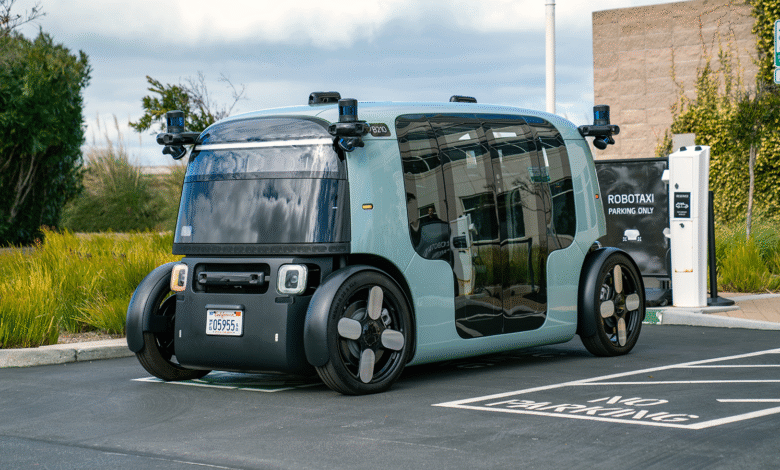Robotaxis: Who Will Dominate in China and Beyond?

Robotaxis are revolutionizing urban transportation, making self-driving cars a viable option for everyday commuting. As the competition heats up in the autonomous taxi market, companies like Alphabet’s Waymo and China’s Pony AI are vying for dominance. With Waymo’s recent expansion featuring over 1,500 robotaxis operating across major U.S. cities, it’s clear that the future of mobility is on the move. In China, the robotaxi market is projected to grow significantly, with estimates suggesting over 300,000 autonomous taxis by 2030. As both nations evolve their transportation landscapes, the race to perfect robotaxis could change how we think about getting from point A to point B.
The emergence of autonomous vehicles signals a transformative shift in transportation modes, often referred to as robotic taxis or self-driving cabs. Industry players, such as Pony AI, are pioneering innovations in the China robotaxi sector, catering to the demand for safer and more efficient travel solutions. Meanwhile, Waymo’s international growth reflects the expanding possibilities for self-driving technology beyond just localized markets. As the future unfolds, these advanced transportation solutions not only promise convenience but also harness the collaboration of various tech giants vying for leadership in autonomous mobility. With cities increasingly adopting this technology, the horizon looks bright for the evolution of on-demand transportation.
The Rise of Robotaxis in Urban Transportation
Robotaxis are rapidly transforming urban mobility, heralding a new era of transportation that blends technology with convenience. As autonomous taxis become more prevalent, cities worldwide are adapting to accommodate these self-driving cars. Companies like Waymo lead the charge in the U.S., boasting a significant number of robotaxi trips, while in China, startups such as Pony AI are taking strides to capture the local market. The integration of robotaxis into everyday urban life signifies a departure from traditional automotive reliance, paving the way for a future where mobility is seamlessly linked to technological innovation.
With the recent developments in robotaxi services, cities are witnessing not just a shift in transportation methods but also a ripple effect in economic opportunities. As companies expand their fleets and operational areas, urban centers are set to reap the benefits of reduced congestion, lower emissions, and improved safety metrics. By 2030, projections suggest that robotaxis could constitute over 5% of on-demand transport in major cities globally. The growing acceptance of autonomous taxis as a viable alternative underlines the importance of investing in and regulating this new mode of transport.
Pony AI’s Dominance in the China Robotaxi Market
Pony AI is positioned as a frontrunner in the rapidly expanding China robotaxi market, showcasing its ability to operate across multiple cities including Beijing and Shanghai. By harnessing advanced autonomous technology, Pony AI has not only been permitted to charge fares but also demonstrates a commitment to improving its service efficiency. The company’s fleet is reportedly receiving numerous ride requests daily, indicating robust consumer interest and potential for scalability. Analysts believe that as Pony AI enhances its operational capacity, it will achieve better profitability through economies of scale.
In a country where competition is fierce, Pony AI’s focus on safety and cost reduction places it ahead of its rivals. By leveraging innovation to slash production costs of its autonomous driving kits significantly, Pony AI is setting a precedent in the robotaxi sector. With substantial growth projections in the number of operational robotaxis by 2030, the company is poised to be a major player, influencing not just local markets but potentially setting global standards for autonomous vehicle regulation and technology.
Waymo’s Expansion Strategy and Global Presence
Waymo’s entry into international markets marks a significant milestone in its quest to become a leader in the autonomous vehicle industry. By establishing a foothold in Japan, the company is not only expanding its operational regions but also testing its technology in diverse environments. This strategic move aims to enhance the brand’s global recognition and operational capabilities, inviting scrutiny and interest from transportation authorities around the world. As Waymo develops its technology, its experiences in international markets can provide valuable insights into the nuances of varying regulatory landscapes.
The competition is not only localized; companies like WeRide and Baidu are actively pursuing opportunities beyond China, seeking to replicate their success in regions like Europe and the Middle East. Collaborations with established ride-hailing platforms reflect a strategy to leverage existing infrastructure while penetrating new markets. Waymo’s expansion is emblematic of the tidal shift towards autonomous mobility solutions globally, encouraging innovation and competition that could redefine transportation in major urban centers.
The Economic Impact of Robotaxis
The advent of robotaxis holds promising economic implications, especially in urban centers aimed at sustainability and efficiency. By reducing the cost and complexity associated with traditional taxi services, robotaxis can potentially lower transportation expenses for consumers while creating new job opportunities within tech and service sectors. As companies like Pony AI and Waymo grow, they foster a competitive environment that encourages innovation, not just in autonomous technology but in the service delivery models for urban transportation.
Moreover, robotaxi services are expected to stimulate local economies by creating ancillary services, ranging from maintenance and software development to infrastructure improvements. As urban planners integrate robotaxis into public transportation networks, residents will likely experience improved mobility options that complement existing public transit. The ongoing evolution of mobility through robotaxis thus not only transforms how cities operate but also shapes broader economic dynamics associated with transportation.
Safety and Regulations in Robotaxi Operations
As robotaxi services become more commonplace, safety concerns and regulatory requirements are paramount. Companies like Pony AI are prioritizing safety enhancements to ensure the reliability of their autonomous vehicles in urban environments. The ability to hail robotaxis quickly and safely can influence public perception and adoption rates. Furthermore, continuous improvement in safety technologies is vital for compliance with evolving regulations, ensuring that robotaxis meet stringent operational standards before deployment.
Legislators around the world are beginning to recognize the potential benefits of robotaxi services, but they also face the challenge of developing appropriate regulatory frameworks. Balancing technological innovation with community safety will require collaboration between autonomous vehicle operators and government entities. As the industry evolves, establishing clear guidelines will be crucial for fostering trust in robotaxis as a safe and reliable transportation option.
Comparative Analysis: U.S. vs. China Robotaxi Markets
The competitive landscape of robotaxis in the U.S. and China presents a fascinating case study in how different markets are adapting to autonomous transportation. In the U.S., Waymo’s advancements in technology and operational scale have positioned it as a leader in robotaxi services. Conversely, China’s market, characterized by its rapid growth and aggressive competition, sees players like Pony AI pushing boundaries in deployment and service efficiency. The contrasts between these markets illustrate differing regulatory environments, consumer behavior, and technological infrastructure.
While Waymo has made strides in major U.S. cities, China’s approach, with robust financial backing and government support for autonomous technologies, is propelling companies like Pony AI into new territories. The forecast for both markets suggests significant developments; however, the strategies deployed by each player will affect their long-term viability and market share. Observers will watch closely as both markets evolve to understand the global trajectory of robotaxis.
Future Developments in Robotaxi Technology
The future of robotaxi technology appears promising, with significant investments and innovations driving the industry forward. As companies like Pony AI and WeRide refine their autonomous systems, advancements in AI, sensor technology, and communication networks will enhance the operational capabilities of these vehicles. Research into optimizing the driving algorithms and safety features of robotaxis will likely accelerate, enabling a higher degree of autonomy and reliability for users.
We can anticipate the emergence of additional features in robotaxis, such as integrated navigation improvements, passenger personalization, and enhanced user interfaces. As companies experiment with cutting-edge technologies, consumer experiences in robotaxis will evolve, making the process increasingly user-friendly and efficient. The race to develop next-generation robotaxi technology underscores the urgency for manufacturers to stay ahead in the competitive landscape, ensuring they meet market demands and regulatory challenges.
Challenges Facing Robotaxi Adoption
Despite the potential benefits of robotaxis, several challenges remain that could impede widespread adoption. Public perception of safety is a critical concern; incidents involving autonomous vehicles can lead to skepticism among potential users. Companies must invest heavily in public education to demonstrate the efficacy and safety of robotaxi services, especially as they seek to attract users who may be hesitant to embrace such technologies.
Moreover, regulatory hurdles pose significant barriers to entry in many markets, with varying laws regarding autonomous vehicles. Navigating the complex legal landscape requires coordinated efforts between tech companies and lawmakers to establish coherent guidance that encourages innovation while ensuring public safety. Addressing these challenges will be crucial for robotaxi services to flourish in both local and global contexts.
The Role of Traditional Automotive Companies in the Robotaxi Evolution
Traditional automotive companies are increasingly recognizing the importance of incorporating autonomous technology into their business models as competition intensifies with the rise of robotaxis. Automakers must adapt to the shifting landscape by investing in self-driving technology or forming partnerships with established robotaxi operators. This strategic pivot is crucial as newcomers like Pony AI and Waymo disrupt the market, pushing conventional players to innovate or risk obsolescence.
As legacy automakers explore the robotaxi sector, they will likely bring valuable experience in vehicle design and production scale to the table. Collaborations between traditional automotive giants and tech startups may lead to hybrid approaches in deploying robotaxi services, blending established manufacturing prowess with cutting-edge technology. With the industry’s trajectory leaning towards autonomy, the integration of traditional and new players will shape the future of transportation.
Frequently Asked Questions
What are robotaxis and how do they operate?
Robotaxis, or autonomous taxis, are self-driving vehicles designed to transport passengers without human intervention. Companies like Waymo and Pony AI are leading the way in this technology, enabling safe and efficient rides in urban areas.
How is Pony AI positioned in the Chinese robotaxi market?
Pony AI is a prominent player in the China robotaxi market, being the first to charge for rides in key cities such as Beijing and Shanghai. The company is focused on expanding its fleet and enhancing operational safety, which is crucial for scaling its services.
What has been the impact of Waymo’s expansion on robotaxi services?
Waymo’s expansion into international markets signifies the growing acceptance of robotaxis globally. By entering markets like Japan, Waymo not only increases competition but also elevates standards for safety and reliability in autonomous transportation.
How does the cost of robotaxis compare among different companies?
The cost of deploying robotaxis varies significantly among companies. For example, Waymo’s cars are estimated to cost around $200,000, while Baidu’s Apollo RT6 is approximately $37,000 and Pony AI’s vehicles run about $42,000, indicating diverse pricing strategies in the autonomous taxi industry.
What is the forecast for the growth of robotaxis in China?
According to Barclays estimates, China is expected to deploy around 300,000 robotaxis by 2030, capturing at least 5% of on-demand transportation in major cities. This growth reflects the rapid advancements and investment in the China robotaxi market.
How do robotaxis improve transportation safety?
Robotaxis enhance transportation safety by utilizing advanced sensors and AI-driven decision-making to navigate traffic and avoid accidents. Companies like Pony AI are actively working on improving safety protocols to ensure public confidence in autonomous vehicles.
What opportunities exist for robotaxi operators outside of China?
Robotaxi operators like WeRide are exploring opportunities in international markets, including Europe and the Middle East. Their ability to secure autonomous driving permits in regions like Saudi Arabia showcases the potential for significant growth outside China.
How does customer demand influence robotaxi developments?
Customer demand plays a crucial role in shaping robotaxi developments. As more people seek convenient and cost-effective transportation options, companies like Waymo and Pony AI are investing in technology and expanding operations to meet these needs.
What safety measures are being implemented in robotaxi services?
Robotics firms are implementing an array of safety measures for robotaxi services, including real-time data analysis, route optimization, and extensive testing in varied weather and traffic conditions to ensure the reliability and safety of autonomous rides.
What are the challenges facing robotaxis in scaling operations?
Challenges facing robotaxis in scaling operations include regulatory hurdles, safety concerns, and the high costs of developing and maintaining autonomous technology. Companies must navigate these obstacles while maintaining profitability and operational efficiency.
| Key Point | Description |
|---|---|
| Robotaxi Deployment in the U.S. | Waymo has over 1,500 robotaxis on the road in cities like San Francisco and Los Angeles, conducting over 250,000 paid trips weekly. |
| Robotaxi Market in China | Approximately 2,000 robotaxis currently in operation, with projections of 300,000 by 2030, accounting for 5% of urban transportation. |
| Pony AI’s Breakthrough | Pony AI is the first to charge fares for rides in major Chinese cities and claims significant daily order volumes per vehicle. |
| Safety Improvements | Focus on improving safety and reducing costs, with a 70% reduction in parts needed for autonomous vehicle kits. |
| Expansion of Operations | WeRide and Baidu are expanding to international markets, including the UAE, Saudi Arabia, and Europe. |
| Economics of Robotaxi Production | Baidu and Pony AI are nearing breakeven on robotaxi operations with significantly lower production costs than competitors. |
Summary
Robotaxis are rapidly transforming transportation, with significant advancements seen in both the U.S. and China. Major players like Waymo and Pony AI are leading the charge, promising to reshape urban mobility. As competition heats up, the focus will undoubtedly shift towards safety and cost-effectiveness, paving the way for a future where autonomous taxis become a commonplace reality.




